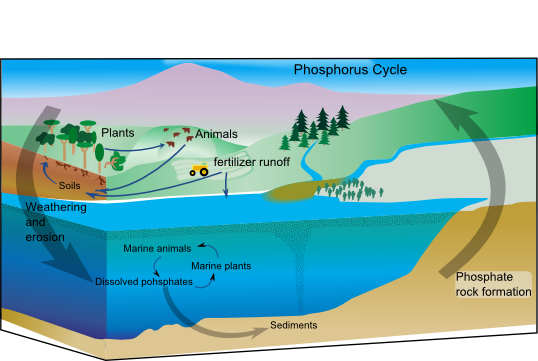Sumi Vora
AP Environmental Science ♻️
252 resourcesSee Units
Movement of Matter
The earth is a closed system; matter can never be removed or created. Instead, matter moves across the earth in cycles called biogeochemical cycles. These basic cycles are essential for supporting life on Earth, but when they are disrupted, it can cause matter to get “stuck” or move too quickly between stages.
Phosphorus Cycle 🗻
Phosphorus is really similar to nitrogen. We need phosphorus for DNA, RNA, and ATP, and it is also a limiting macronutrient. Phosphorus only cycles between land and water -- not the atmosphere. And, phosphorus doesn’t change form like nitrogen (bless up 🙌) -- it is almost always found as phosphate (PO4).

Source: NASA Earth Observatory
Plants assimilate phosphate, and when organisms die, fungi and bacteria mineralize phosphate and it goes back into the soil. This is really similar to the nitrogen cycle, but without all of the chemical changes.
The other portion of the phosphorus cycle involves the movement of phosphorus between land and water. Just like the carbon cycle, this is the slow part of the phosphorus cycle. Phosphorus enters the ocean through precipitation or runoff, but it doesn’t dissolve in the water. Instead, phosphorus is deposited in the sediments at the bottom of the ocean.
Over time, a process called geologic uplift brings the ocean layers up to become mountains, and the phosphate rocks weather which brings the nutrient into the soil. Phosphate usually clings tightly onto soil, and like we’ve seen before, it doesn’t dissolve easily in water. Therefore, phosphate is a limiting nutrient for aquatic ecosystems.
Human Impacts on the Phosphorus Cycle🙌
The two main anthropogenic sources of phosphorus are laundry detergents and synthetic fertilizers
Like nitrogen, phosphorus plays a big role in plant growth, so humans often add it to synthetic fertilizers. The excess phosphorus often runs off into nearby bodies of water, leading to excess algae growth that prevents sunlight from penetrating the water. The existing aquatic plants die and eat up all the available oxygen, which leads to massive dead zones in the water.
As we have seen with nitrogen, phosphorus can also alter plant communities especially in aquatic systems, causing smaller plants to die off as the larger ones grow larger.
Browse Study Guides By Unit
🏜Unit 1 – The Living World: Ecosystems
🐠Unit 2 – The Living World: Biodiversity
👪Unit 3 – Populations
🌏Unit 4 – Earth Systems & Resources
🏖Unit 5 – Land & Water Use
⚡️Unit 6 – Energy Resources & Consumption
💨Unit 7 – Atmospheric Pollution
♻️Unit 8 – Aquatic & Terrestrial Pollution
🔥Unit 9 – Global Change
🧐Multiple Choice Questions (MCQs)
✍️Free Response Questions (FRQs)
📆Big Reviews: Finals & Exam Prep

Fiveable
Resources
© 2023 Fiveable Inc. All rights reserved.